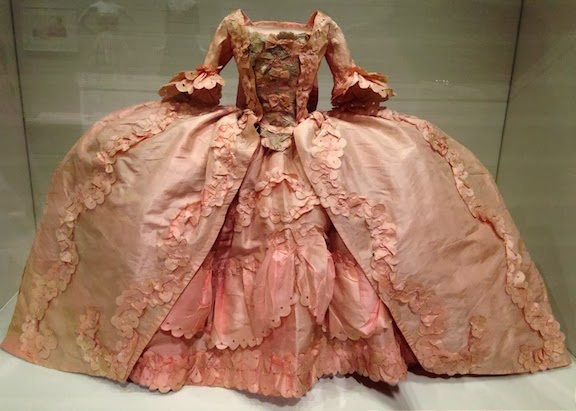From sometime in the 1400s it became the practice to make up dolls that were dressed in the very latest fashions, and then send those dolls out over Europe, to promote trade in textiles and luxury goods, while also letting dressmakers and tailors know what the up to date fashions were. By the later 1600s fashionable dressmakers and tailors would have a few of these dolls sitting about in their shops so that clients could see, in three dimensions, the latest modes.
At their greatest popularity, during the 1700s, there were probably thousands of these dolls circulating the western world, though few of them remain. I suspect that most of them ended up becoming children's toys, and probably got loved to pieces. They were most often painted wood, though there are examples of china Pandoras, and cloth ones as well.
There became two separate versions of Pandora; Greater and Lesser Pandora. Lesser Pandora would be dressed in daytime clothing and accessories, and Greater Pandora was always in evening and formal attire. The dolls were completely togged, including the correct underclothes, stockings, hats, shoes, hairdress and makeup, and even jewelry. It was vital to trade that these dolls be as accurate as possible so that makers of fabrics could sell their newest materials, and purveyors of things like lace and passementerie could get advertising as well.
Though the vast majority of the Pandoras were dressed in female attire, there are a few existing male Pandoras, those that do exist seem to be only for formal dress. And Pandoras were sometimes accessorized even to the extent of having sedan chairs. The idea was, just like it was with fashion plates, not only to present fashion at its most current, but to convey some sense of appropriate comportment as well.
Pandora dolls faded out of use as fashion periodicals took hold and began to dominate the market. Also, the ready availability of a broader range of textiles made their use obsolete. It was not until just after WWII that we would see them again in a pair of unique manners.
One was the Theatre de la Mode, produced by the French couture industry right after the war to remind the world of France's primacy as a center of fashion. Over one hundred dolls, each dressed by different couturiers down to tiny shoes and hats were arranged in a series of environments designed by some of the greatest artists of the time. The Theatre toured both Europe and the United States to great delight.
Pandora traveled the world and informed a great many people of what was going on in Attire, while also forwarding trade. We are unlikely to see her come back into favor, we have moved beyond the need. But Pandoras do remain to teach us how we did things, and how we thought.
As a final note, the majority of the Theatre de la Mode still exists, and is part of the permanent collection of the Maryhill Museum of Washington state.













One could view the first Barbie as an echo of Pandora. Certainly later decades with the popular designers of the day giving their vision.
ReplyDeleteHave you visited Maryhill and the Theatre de la Mode on any of your trips up? Pretty fabulous!
ReplyDeleteNot yet, but boy oh boy is it on my bucket list.
DeleteDelightful!
ReplyDeleteI just found your lovely site. I live in Portland and have visited the Theatre de la Mode since I was a little girl. It actually tortured me when it was sent out to be restored and then to be toured. But it came back to Maryhill better than ever and I am still loving the collection at age 70.
ReplyDeleteKathryn, Thanks so much, both for discovering Attire's mind, and for your sweet rememberings. I have yet, myself to see them in real time. I'm just so glad that they still exist to tell their story to us.
Delete